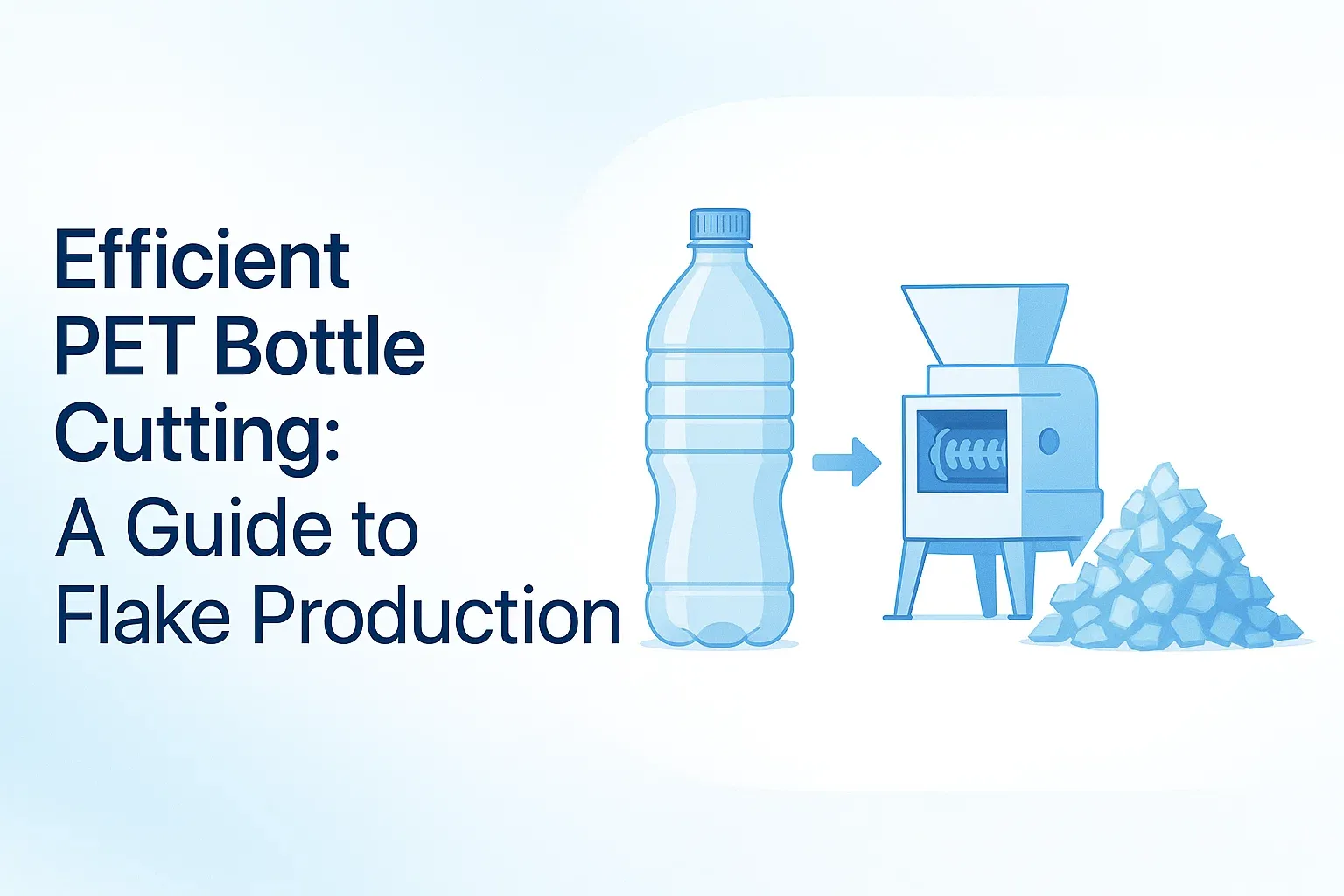From Bottles to Flakes: An Engineer’s Guide to Efficient PET Cutting
Polyethylene terephthalate (PET) bottles are ubiquitous in modern life. But what happens after we toss them into the recycling bin? For engineers, industrial equipment purchasers, and technical personnel in the recycling sector, this is where the fascinating journey of transforming waste into valuable raw material begins. A critical step in this process is efficiently cutting PET bottles into flakes. This guide will delve into the intricacies of this process, exploring the machinery, techniques, and considerations for achieving optimal efficiency and quality.
The global push for sustainability and a circular economy has put PET recycling in the spotlight. High-quality PET flakes are in demand for manufacturing a wide range of products, from new bottles and packaging to fibers for clothing and carpets, and even components in the automotive industry. Efficiently producing these flakes is paramount for both environmental and economic reasons.
Why Efficient PET Flake Production Matters
Before diving into the “how,” let’s briefly touch upon the “why.” Efficient PET bottle cutting offers several key advantages:
- Maximizing Material Value: Consistent, high-quality flakes command better prices in the market.
- Reducing Processing Costs: Efficient machinery consumes less energy, requires less maintenance, and minimizes material loss.
- Enhancing Throughput: Faster and more effective cutting means a higher volume of PET can be processed, increasing overall plant capacity.
- Improving Downstream Processes: Uniform flake size and minimal fines (small, powder-like particles) lead to smoother operation in subsequent washing, drying, and extrusion stages.
- Minimizing Environmental Impact: Optimized processes reduce waste and the overall carbon footprint of recycling operations.
The Heart of the Matter: PET Bottle Granulators and Shredders
The primary workhorses for cutting PET bottles into flakes are granulators and, in some cases, shredders used in a pre-cutting stage.
- PET Bottle Granulators: These machines are specifically designed to reduce whole or pre-shredded PET bottles into consistently sized flakes. They typically employ a high-speed rotor with multiple knives that cut the material against stationary bed knives. The screen size determines the final flake dimensions.
- Shredders (for PET): While granulators do the fine cutting, heavy-duty shredders can be used as a preliminary step, especially for baled or densely packed bottles. Shredders break down the bulk material into smaller, more manageable pieces, which then feed into the granulator for precise flaking. This two-stage approach can improve the efficiency and reduce wear on the granulator.
Key Components of a PET Bottle Granulator:
Understanding the anatomy of a granulator is crucial for appreciating its operation and maintenance:
- Hopper: The entry point for the PET bottles. Design can vary for manual or automated feeding.
- Rotor: The central rotating component fitted with multiple knives. Rotor designs (e.g., open, closed, staggered) can impact cutting efficiency and material flow.
- Rotor Knives (Fly Knives): These knives are mounted on the rotor and perform the primary cutting action.
- Bed Knives (Stationary Knives): Fixed knives mounted within the cutting chamber that work in conjunction with the rotor knives to create a scissor-like cutting action.
- Режущая камера: The enclosed area where the cutting takes place. Its design influences how material moves and is cut.
- Screen: A perforated plate located beneath the cutting chamber. The size of the holes in the screen dictates the maximum size of the output flakes.
- Drive Motor: Powers the rotor. Motor size is a critical factor in determining the granulator’s throughput and ability to handle varying loads.
- Discharge System: Collects the processed flakes, often via a blower or conveyor system.
(Imagine a schematic diagram here showing the internal components of a typical PET bottle granulator, labeling the hopper, rotor, rotor knives, bed knives, cutting chamber, screen, and motor.)
Optimizing Efficiency in PET Bottle Cutting: Key Considerations
Achieving peak efficiency in PET bottle flaking isn’t just about having the right machine; it’s about a holistic approach encompassing several factors:
1. Material Preparation: The Crucial First Step
- Sorting and Cleaning: While not part of the cutting process itself, the quality of the input material significantly impacts granulator performance and flake quality. Removing contaminants like PVC bottles, metal, stones, and excessive dirt is vital. Pre-washing can also be beneficial.
- Bale Breaking (if applicable): If bottles are received in bales, efficient bale breakers are needed to separate them before they enter the shredder or granulator.
- Pre-Shredding (Optional but often beneficial): As mentioned, using a shredder for initial size reduction of whole or baled bottles can:
- Increase the throughput of the downstream granulator.
- Reduce wear and tear on the granulator knives.
- Provide a more consistent feed to the granulator.
2. Granulator Selection and Configuration:
- Rotor Design and Speed: Different rotor designs excel with specific material types and throughput requirements. Higher speeds generally mean finer particles, but also more fines and heat generation. The “V-cut” or “chevron” rotor design is popular for PET bottles as it pulls material towards the center of the rotor, ensuring a clean cut and reducing wear.
- Knife Material and Sharpness: High-quality, durable knives (often made from D2 tool steel or similar) are essential. Maintaining knife sharpness is paramount. Dull knives tear rather than cut, leading to:
- Increased fines generation.
- Higher energy consumption.
- Increased heat buildup, which can degrade PET.
- More frequent knife changes and higher maintenance costs.
- Knife Gap: The clearance between the rotor and bed knives must be precisely set and maintained. An incorrect gap leads to inefficient cutting, increased fines, and potential machine damage. For PET, a tight tolerance is usually preferred.
- Screen Size and Type: The screen hole diameter directly controls the output flake size. Choosing the right screen is critical for meeting downstream processing requirements. Round or square holes are common.
- Мощность двигателя: The motor must be adequately sized for the desired throughput and the density of the PET bottles being processed. An undersized motor will struggle, leading to jams and reduced efficiency.
- Feeding Mechanism: Consistent and controlled feeding of bottles into the granulator is crucial. Overfeeding can choke the machine, while underfeeding reduces throughput. Automated conveyor systems with metal detectors are recommended.
3. Operational Best Practices:
- Regular Maintenance: This cannot be overstated.
- Knife Sharpening/Replacement: Implement a proactive schedule.
- Screen Cleaning/Inspection: Ensure screens are not clogged or damaged.
- Bearing Lubrication: Follow manufacturer recommendations.
- Belt Tensioning: Check and adjust drive belts.
- Dust and Fines Management: PET processing can generate dust and fines. Efficient extraction systems are necessary for:
- Operator safety and workplace cleanliness.
- Preventing contamination of flakes.
- Reducing the risk of dust explosions (though less common with PET than other plastics).
- Temperature Control: Excessive heat buildup in the cutting chamber can soften and degrade PET, leading to smearing and reduced flake quality. Some granulators offer water-cooling options for the cutting chamber or rotor. Ensuring good airflow and not overworking the machine also helps.
- Noise Reduction: Granulators can be noisy. Enclosures and other noise-dampening measures may be necessary to comply with workplace safety regulations and improve the working environment.
- Automation and Control Systems: Modern granulators often feature PLCs (Programmable Logic Controllers) for monitoring operating parameters, detecting overloads, and automating shutdown procedures, enhancing both efficiency and safety.
Performance Comparison: Key Metrics for PET Granulators
When evaluating different PET granulators or optimizing an existing setup, consider these performance indicators:
| Feature/Metric | Desired Outcome for High Efficiency | Impact on Operations |
| Throughput (kg/hr) | High, meeting or exceeding plant requirements | Directly impacts overall plant capacity and profitability. |
| Flake Size Consistency | Uniform flake size with minimal deviation | Improves downstream processing (washing, extrusion). |
| Fines Generation | Low (typically <5%) | Reduces material loss, improves final product quality. |
| Energy Consumption (kWh/ton) | Низкий | Reduces operational costs, improves sustainability. |
| Knife Lifespan | Long, requiring infrequent sharpening/replacement | Reduces maintenance downtime and costs. |
| Maintenance Downtime | Minimal | Maximizes operational uptime and productivity. |
| Noise Level (dB) | Low, meeting safety standards | Improves workplace environment, ensures compliance. |
| Ease of Cleaning/Access | Designed for quick and easy cleaning and knife changes | Reduces downtime for maintenance and material changeovers. |
Addressing Common Challenges in PET Flaking
Several challenges can arise during the PET bottle cutting process:
- Contamination: Labels, caps (often PP or PE), adhesives, and other non-PET materials can contaminate the flakes. While some of this is addressed in upstream sorting and downstream washing, the granulator itself can be impacted. For example, adhesives can build up on knives and screens.
- Solution: Robust upstream sorting, high-quality labels designed for recycling, and regular cleaning of the granulator.
- High Fines Content: As discussed, this is a major issue.
- Solution: Sharp knives, correct knife gap, appropriate screen size, controlled feeding, and avoiding excessive rotor speed. Air classification systems downstream can also help separate fines.
- Wear and Tear on Knives and Screens: PET is abrasive, leading to wear.
- Solution: Use of high-quality, wear-resistant materials for knives and screens, proper maintenance, and potentially pre-shredding to reduce the load on the granulator.
- Machine Jams: Can be caused by overfeeding, large contaminants, or dull knives.
- Solution: Controlled feeding, effective pre-sorting, maintaining sharp knives, and overload protection systems.
- Heat Buildup:
- Solution: Proper ventilation, not overworking the machine, water-cooling options where available, and ensuring sharp knives (dull knives generate more friction and heat).
The Future of PET Flake Production: Trends to Watch
The technology for PET bottle cutting is continuously evolving, driven by the need for higher efficiency, better quality, and lower costs:
- Increased Automation: More sophisticated control systems, predictive maintenance sensors, and robotic integration for feeding and quality control.
- Improved Knife Designs and Materials: Development of even more durable and wear-resistant knife materials and geometries to extend lifespan and improve cutting performance.
- Smart Granulators: Integration of IoT (Internet of Things) technology for remote monitoring, data logging, and performance optimization.
- Energy Efficiency Focus: Continued emphasis on designing machines that consume less energy per ton of PET processed.
- Better Fines Management and Re-integration: Innovations in separating and potentially re-processing fines to minimize waste.
- Enhanced Integration with Washing Lines: More seamless connection and communication between granulation and washing modules for optimized overall line performance.
Conclusion: Investing in Efficient PET Cutting Pays Off
Efficiently cutting PET bottles into high-quality flakes is a cornerstone of successful PET recycling operations. For industrial equipment purchasers, engineers, and technical personnel, understanding the nuances of granulator technology, optimal operational practices, and ongoing maintenance is key. By focusing on material preparation, selecting the right equipment, and adhering to best practices, recycling facilities can maximize their throughput, produce superior flakes, reduce operational costs, and contribute significantly to a more sustainable future. The journey from bottle to flake is a technical one, but with the right knowledge and equipment, it’s a journey that delivers both economic and environmental rewards.



